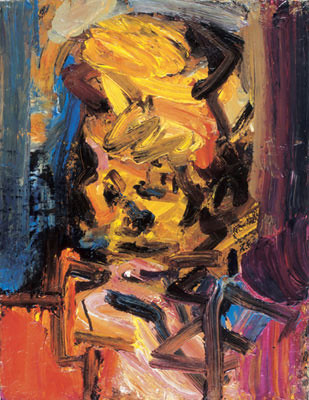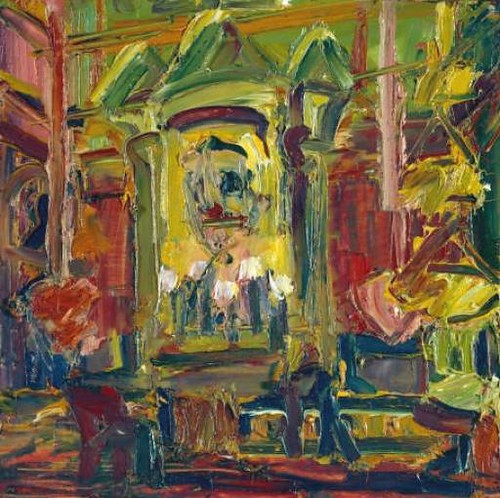Frank Auerbach (original) (raw)

Augusta Stylianou Gallery
<-----===========------->
Loading
Artist Index
A - B - C - D - E - F - G - H - I - J - K - L - M
N - O - P - Q - R - S - T - U - V - W - X - Y - Z
Frank Helmut Auerbach (born 29 April 1931) is a German-born British painter.[1] His work typically portrays either one of a small group of mainly female models, or scenes around London, especially Camden Town.[1][2]
Career
Frank Auerbach was born in Berlin, Germany, to Max Auerbach and Charlotte Nora Burchardt, both of whom had studied art.[3] His parents sent him to England in 1939 to escape the Nazis as part of the Kindertransport programme.[4] (The family was Jewish; his parents subsequently died in a concentration camp). He left Germany 7 April 1939, a month before his eighth birthday, to attend Bunce Court, a boarding school for refugees near Faversham in Kent, where he was sponsored by the writer Iris Origo. At Bunce Court, he was already seen as an artistic prodigy, and where his work already showed an expressionistic style. He also distinguished himself there as a stage actor.[1][5] Auerbach has remained in England ever since, taking British nationality in 1947.[citation needed] He studied art at St Martin's School of Art in London and later at the Royal College of Art, but was more strongly influenced by lessons with David Bomberg at Borough Polytechnic, and especially so by Bomberg's exploratory attitude. He also encouraged his St Martin's classmate Leon Kossoff to attend Bomberg's classes.[1]
Auerbach, Frank -1990 Head of Julia II
At 17, while playing a bit part in Peter Ustinov's first play House Of Regrets, he met the 32-year-old Estella Olive West, (generally known as "Stella" but referred to as "E. O. W." in the titles of his works), a widowed amateur actress who ran a boarding house in Earl's Court whose residents at the time included historian and novelist Len Deighton. She would be his lover for the next 23 years (including after his marriage to fellow Royal College of Art student Julia Wolstenholme) and also one of his most-depicted models. With her, he established his pattern of working and reworking paintings, so that some works took hundreds of sittings to complete: "It was quite an ordeal," West later remembered, "because he would spend hours on something and the next time he came he would scrape the whole lot down. That used to upset me terribly. I wondered what I was doing it all for." Their relationship was "often fraught, occasionally bordering on violence"; both agree that the violence was mainly Stella's, but that his work captured that intensity.[1][6]
Auerbach, Frank (1931- ) - 1976 Rimbaud
His paintings of E. O. W. featured in Auerbach's 1955 Royal College of Art graduation show, leading Helen Lessore of the Beaux Arts gallery to give him his first solo exhibition in January 1956. While reviews of that show were mixed, David Sylvester of The Listener declared it "The most exciting and impressive first one-man show by an English painter since Francis Bacon in 1949."[1] Auerbach had five solo shows at the Beaux Arts Gallery between 1955 and 1963.[3] In the early 1960s he contributed to X magazine, founded by the painter Patrick Swift, along with fellow artists Bacon, Lucian Freud, Kossoff, Michael Andrews, et al. While still a student at the Royal College, he took over from his friend Leon Kossoff the Camden studio that has been his base since.[2] (Before Kossoff, the studio had been used by Gustav Metzger, who was also a young Jewish refugee from Nazi Germany.[3]) He was slow to find his artistic bearings again; in nearly two years he produced no paintings, and only 10 drawings. "I somehow felt that what had been private had become public," the Guardian quoted him saying in 2001. "I had put myself into a uniform: there I was, this chap who had done these thick paintings in earth colours."[1] From 1958 to 1965 he was a member of staff at Camberwell School of Arts and Crafts at the behest of Robert Medley.[7] Auerbach married Julia Wolstenholme in 1958; they had one son, Jake; but they broke up over his continuing, passionate relationship with Stella West. They reunited in 1976, after he and Stella West had split.[1]
Paintings and technique
Head of Julia, 1960. Private collection.
Auerbach is a figurative painter, usually taking personal friends as his subject,[2] with three people being used time and again: his wife Julia; the professional model, Juliet Yardley Mills (usually referred to as "J. Y. M." in titles); and his friend and lover, Stella West.[1] He has also made a number of landscapes of scenes close to his London home, often taking building sites as the subject rather than the traditional hills and sheep.[3] Recurring subjects in his Camden landscapes are Mornington Crescent and the adjacent Art Deco former Carreras cigarette factory and nearby Camden Palace dance club (originally a music hall); the most pastoral setting is nearby Primrose Hill.[2]
Auerbach does not prepare underpaintings, nor does he use outline sketches for portraits, and he relies on his sitters being able to reassume the same pose session after session. In contrast, he sketches landscapes in the field and brings the sketches back to the studio, sometimes using as many as 200 sketches for a single painting.[2]
His work might broadly be described as expressionist. Many of his paintings display an extremely thick impasto, something which he was criticised for at his 1956 Beaux Arts solo show, where some of the paintings were displayed flat rather than hanging, for fear that the paint would fall off from its own weight.[8] The impasto, which grew even heavier over the next decade (but later decreased, as he began scraping down his paintings more as he worked),[1] is sometimes so heavy that the paint seems to have been sculpted rather than brushed on.
A similarly sculptural aspect can often be found in his drawings: Auerbach layers multiple sheets of paper as much as half an inch in thickness and in some parts of the drawing he may erase so heavily as to go through several sheets. This can be readily seen in the area surrounding the upper part of the head in his 1960 Head of Julia.[2] The extreme predominance of earth colors in his early work was largely a matter of budget: a £1,500 annuity from the Beaux Arts allowed him to broaden his palette, which can be seen in his works once he resumed painting. Colors such as aquamarine and cadmium red began to appear in his paintings.[1] The gallery guide to the 2001 Royal Academy retrospective says that "The physical effort required to produce the large works is enormous. Painting the ultimate version of the composition, laid over the scraped-off remains of so many predecessors, frequently demands six or more hours of intense activity." Similarly, in discussing one of his paintings of Primrose Hill, "Reading an Auerbach painting is an energetic experience… Furiously worked pink vibrates in a different way to swift interlinked zigzags of red and green, while a marbled sky offers an area of tranquility."[2]
Major exhibitions
The first major retrospective of Auerbach's work was presented in 1978 by the Arts Council of Great Britain for the Hayward Gallery, London, and then toured to the Fruitmarket Gallery, Edinburgh. Other major shows have included "Frank Auerbach: Paintings and Drawings 1977–85" at the British Pavilion at the XLII Venice Biennale (1986), where he shared the Golden Lion prize with Sigmar Polke; "Frank Auerbach at the National Gallery: Working after the Masters" (1995), at the National Gallery, London, presented drawings made over a thirty-year period from paintings in the National Gallery's collection; a major retrospective at the London's Royal Academy in 2001. Many of his works are in the permanent collection of the Tate Gallery.[3] The two most comprehensive retrospectives of his work[9]—the 1978 Hayward show[3] and the 2001 Royal Academy retrospective—were curated by Catherine Lampert.[2]
Auerbach was among the several hundred individuals reported in December 2003 to have refused either knighthoods or other UK honours. He was reported to have been offered a knighthood.[10]
In literature
Auerbach was the inspiration for the character of Max Ferber (named Max Aurach in the German original) in W. G. Sebald's novel The Emigrants. Several of Auerbach's paintings appear in the German version of the novel, but he refused to let them be reprinted in the English translation.[11]
Notes and references
1. ^ a b c d e f g h i j k John O'Mahony, The Guardian Profile: Frank Auerbach; Surfaces and depths, The Guardian, 15 September 2001. Accessed 30 March 2007.
2. ^ a b c d e f g h Gallery guide, Frank Auerbach: Paintings and Drawings 1954–2001, Royal Academy of Arts, 14 September – 12 December 2001.
3. ^ a b c d e f Auerbach Chronology, The Royal Academy of Arts. Archived on the Internet Archive 13 May 2006. Accessed 30 March 2007.
4. ^ Auerbach biography.
5. ^ Royal Academy of Arts chronology mentions Origo.
6. ^ The gallery guide for the 2001 Royal Academy of Arts retrospective says that Head of E. O. W. (1955) took two years and 300 sittings.
7. ^ Geoff Hassell,Camberwell School of Arts & Crafts. Its Students and Teachers 1943-1960, Woodbridge 1998, p.31
8. ^ John O'Mahony's, Guardian Profile of Auerbach quotes the Manchester Guardian in 1956 as writing, "There seems at present to be some sort of competition going on among young artists, to find out who can put on his canvases the heaviest load of treacly paint."
9. ^ "It's about time", The Guardian's review of the Royal Academy of Arts retrospective, 11 September 2001. Accessed online 30 March 2007.
10. ^ Leak reveals honours snubs, BBC News 21 December 2003. Accessed 28 July 2006.
11. ^ "Recovered memories: The Guardian Profile: WG Sebald". The Guardian. 22 September 2001. http://www.guardian.co.uk/books/2001/sep/22/artsandhumanities.highereducation. Retrieved 10 July 2010.
Further reading
* Hughes, Robert, Frank Auerbach, Thames and Hudson (1990, ISBN 0-500-09211-7), reissued 1992 (ISBN 0-500-27675-7)
* William Feaver, Frank Auerbach, Rizzoli International Publications, Inc.(2009, ISBN 978-0-8478-3058-9)
* An Anthology from X (Oxford University Press 1988). X (magazine) ran from 1959-62. Edited by David Wright & Patrick Swift. Apart from contributions from Auerbach X also included painters such as Bacon, Giacometti, Freud, Bomberg, Andrews, Kokoschka,et al., and writers such as W.H. Auden, Samuel Beckett, et al.
Retrieved from "http://en.wikipedia.org/ ", Text is available under the Creative Commons Attribution-ShareAlike License
==--==--==
==++==++==



